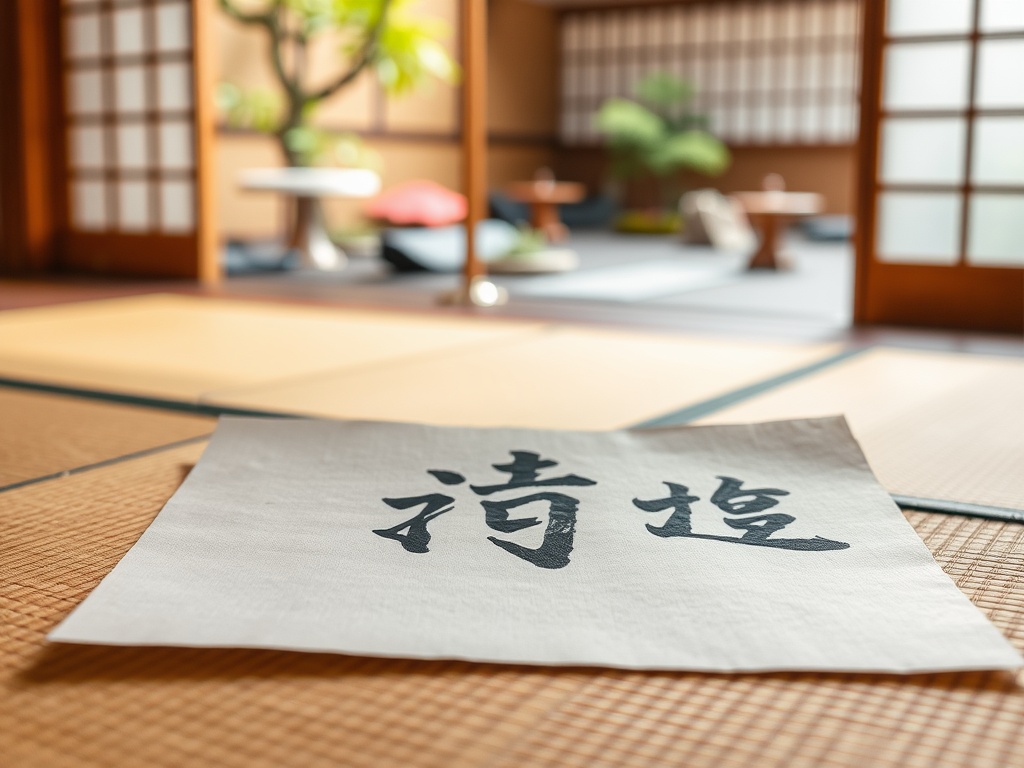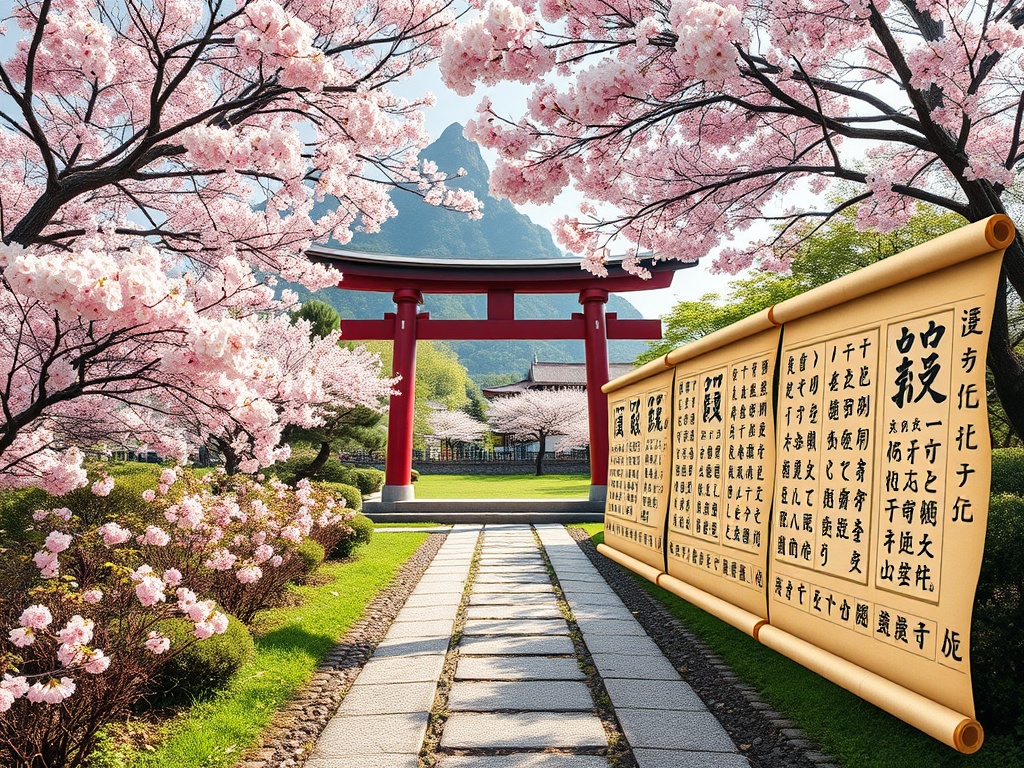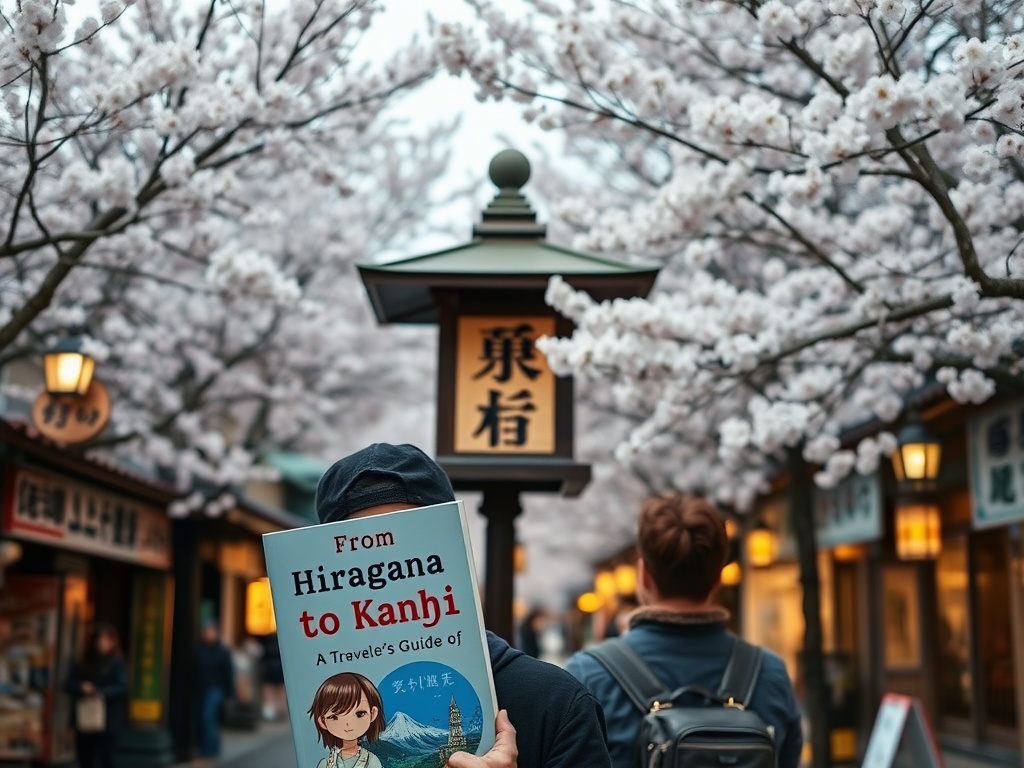Unlocking the Mystery: Decoding the Japanese Language
Win a Free Trip to Japan!
Experience cherry blossoms and ancient temples
Travelers to Japan often find themselves mesmerized by the intricate beauty of Japanese characters. Whether you’re exploring bustling Tokyo or the serene temples of Kyoto, understanding how to write ‘Japanese’ in its native script can enrich your travel experience. Let’s embark on a journey to decode this fascinating language.
The Japanese writing system is a blend of three unique scripts: Hiragana, Katakana, and Kanji. Each has its own role and history, contributing to the linguistic tapestry of Japan. Knowing when and how to use these scripts can be as thrilling as navigating through Japan’s vibrant streets.
- Hiragana: The most basic script, used for native Japanese words and grammatical elements. It’s often the first script children learn.
- Katakana: Used primarily for foreign words, it adds a modern twist to the language. Think of it as the script of choice for global influences.
- Kanji: Borrowed from Chinese characters, Kanji is used for most nouns, verbs, and adjectives. It’s the most complex but also the most rewarding to master.
To truly embrace the cultural essence of Japan, try writing ‘Japanese’ in Japanese characters. Here’s how:
| Script | Characters |
|---|---|
| Hiragana | にほんご |
| Katakana | ニホンゴ |
| Kanji | 日本語 |
Each script offers a different perspective on the word, showcasing the versatility and depth of the Japanese language.
From Hiragana to Kanji: A Traveler’s Guide to Japanese Characters
As you wander through the enchanting landscapes of Japan, from the neon-lit streets of Shibuya to the tranquil gardens of Nara, you’ll encounter the art of Japanese writing at every turn. Understanding these characters not only enhances your travel experience but also offers a deeper appreciation of the cultural nuances that define Japan. This guide will help you navigate the three scripts—Hiragana, Katakana, and Kanji—providing a roadmap for your linguistic journey.
Each script in the Japanese language serves a unique purpose and reflects different aspects of Japanese culture. As a traveler, appreciating these scripts can be as rewarding as savoring sushi or exploring a hidden shrine.
- Hiragana: Known for its flowing curves, Hiragana is often used in literature and daily communication. It is the first script that Japanese children learn, offering a gentle introduction to the language.
- Katakana: With its sharp and angular strokes, Katakana captures the essence of modernity. It’s commonly used for foreign loanwords, brand names, and onomatopoeia—adding a global flair to the Japanese lexicon.
- Kanji: The most intricate script, Kanji, consists of thousands of characters, each with a unique meaning. It draws from ancient Chinese symbols and is essential for reading newspapers, official documents, and traditional texts.
While exploring Japan, knowing which script to use and when can enhance your interactions and experiences. For instance, when reading menus or street signs, Kanji provides essential context, while Katakana is your go-to for understanding foreign influences. Meanwhile, Hiragana is ideal for deciphering children’s books or casual conversation.
| Script | Usage | Examples |
|---|---|---|
| Hiragana | Native words, grammar | にほんご (Nihongo) |
| Katakana | Foreign words, names | ニホンゴ (Nihongo) |
| Kanji | Nouns, verbs, adjectives | 日本語 (Nihongo) |
Embrace the challenge of learning these scripts on your travels, and you’ll find that the language opens new doors to the heart of Japan. Each character you learn is a step closer to understanding the stories and traditions that have shaped this incredible nation.
Mastering the Art of Japanese Calligraphy for Tourists
Embarking on a journey through Japan isn’t just about sightseeing—it’s also a golden opportunity to delve into the artistic traditions that have shaped its culture. One such tradition is Japanese calligraphy, or shodo, an art form that transforms writing into a meditative practice. For travelers, learning to write ‘Japanese’ in its native characters through calligraphy offers a unique window into the soul of Japan, allowing you to engage with its language and history on a deeper level.
Japanese calligraphy is more than just writing; it’s a dance of the brush across paper, a graceful expression of beauty and balance. This ancient art is deeply rooted in Zen philosophy, where each stroke is a reflection of the artist’s inner state. As you learn to write characters like にほんご (Nihongo) in Hiragana, ニホンゴ in Katakana, or 日本語 in Kanji, you’re not just learning a language—you’re participating in a centuries-old tradition.
To truly experience the art of Japanese calligraphy, it’s essential to familiarize yourself with the traditional tools of the trade. Known as the Four Treasures of the Study, these items are indispensable for creating authentic calligraphy:
- Brush (fude): The brush is your primary tool, with varied sizes for different styles and strokes.
- Ink Stick (sumi): Ground and mixed with water, the ink stick is the source of your calligraphic expression.
- Ink Stone (suzuri): A flat stone used for grinding the ink stick to create a smooth, consistent ink.
- Paper (hanshi): Specially designed paper that absorbs the ink beautifully, allowing for bold and delicate strokes alike.
As you traverse Japan, from the bustling metropolis of Tokyo to the historic streets of Kyoto, you’ll find numerous opportunities to try your hand at calligraphy. Many cultural centers and workshops offer classes for beginners, where you can learn under the guidance of skilled calligraphers. These sessions not only teach you the techniques but also offer insights into the cultural significance of each character you craft.
Joining a calligraphy workshop is more than just a lesson—it’s an experience that connects you to the deep-rooted traditions of Japan. Whether you choose to write your name, a favorite phrase, or simply ‘Japanese,’ you’ll be taking home a piece of the culture that transcends language barriers.
Cultural Nuances: Understanding Japanese Script Beyond the Surface
As travelers immerse themselves in the rich tapestry of Japanese culture, the diversity of its language scripts offers a unique lens through which to appreciate its intricate subtleties. Writing ‘Japanese’ in its native characters is more than a linguistic exercise—it’s an exploration of the cultural layers that shape the nation’s identity. Recognizing the nuances within Hiragana, Katakana, and Kanji opens a window to understanding the soul of Japan, much like savoring its culinary delights or observing its traditional festivals.
The Japanese scripts are deeply intertwined with the country’s history and societal values. Each script carries its own symbolism and significance, reflecting the multifaceted nature of Japanese life. Hiragana is often associated with simplicity and elegance, used in literature to convey emotion and subtlety. Its flowing lines evoke a sense of grace that mirrors Japan’s aesthetic sensibilities. Katakana, with its angular form, symbolizes Japan’s adaptability and openness to foreign influence, representing a bridge between traditional and modern. Lastly, Kanji embodies the depth and complexity of Japanese culture, with each character telling a story that has evolved over centuries.
Understanding when and how to use these scripts can significantly enhance your travel experience, turning everyday encounters into moments of cultural insight. Imagine reading a menu and appreciating the careful choice of Kanji to convey the essence of a dish, or recognizing the use of Katakana in branding that highlights international fusion. These scripts are more than tools of communication; they are cultural signifiers that offer a deeper connection to the places and people you encounter.
- Ways to Appreciate Japanese Scripts as a Traveler:
- Observe street signs and their script choices to understand local culture.
- Engage with locals by recognizing and using the appropriate script in conversations.
- Explore cultural sites with an eye for script usage in historical contexts.
By delving into the world of Japanese characters, you not only gain a practical skill but also unlock a richer, more profound understanding of Japan’s cultural narrative. Let each character you learn be a stepping stone toward a more meaningful journey.
Travel with Confidence: Recognizing Japanese Characters in Daily Life
As you embark on your Japanese adventure, the ability to recognize and understand Japanese characters becomes an invaluable skill, enhancing your confidence while navigating this captivating country. From vibrant cityscapes to serene countryside, Japan’s language is seamlessly woven into its everyday life. Mastering the art of writing ‘Japanese’ in its native scripts—Hiragana, Katakana, and Kanji—not only boosts your linguistic skills but also enriches your travel experiences.
In bustling metropolises like Tokyo and Osaka, you’ll find Japanese characters everywhere—from the neon signs that light up the night sky to the intricate kanji on traditional storefronts. Familiarizing yourself with these scripts can transform a simple stroll through the city into a cultural exploration. For instance, understanding Kanji on street signs can guide you through historical districts, while recognizing Katakana on restaurant menus helps you identify international cuisines. Embrace the challenge of deciphering these characters, and you’ll find yourself more connected to the rhythm of urban Japan.
The charm of rural Japan lies in its ability to transport you to a world where tradition and nature coexist harmoniously. In these tranquil settings, Japanese scripts become storytellers of local life and culture. As you explore quaint villages or serene temples, pay attention to the Hiragana inscriptions that often accompany Kanji on informational plaques. These characters not only offer insights into the history and significance of the site but also invite you to engage with the locals, opening doors to warm interactions and authentic experiences.
Recognizing Japanese characters in daily life is more than just a practical skill; it’s a gateway to appreciating Japan’s rich cultural tapestry. Each character you decipher is a step toward understanding the nuanced layers of Japanese identity. Whether you’re ordering a meal, finding your way through the subway, or engaging in casual conversation, your ability to navigate these scripts will empower you to travel with confidence and curiosity. So, let the scripts guide you, and immerse yourself in the harmonious blend of past and present that defines Japan.
Hidden Meanings: How Japanese Characters Tell Stories
As you embark on your journey through Japan, you’ll quickly realize that the country’s language is a tapestry woven with symbols that convey more than just words. Each character, whether written in Hiragana, Katakana, or Kanji, carries with it a depth of meaning that reflects the very essence of Japanese culture. Understanding these hidden meanings is like uncovering the layers of a story, each character revealing a piece of Japan’s rich history and traditions.
The storytelling power of Japanese characters is unparalleled. Take Kanji, for example, which is not merely a script but a gateway into the past. Each Kanji character is imbued with historical significance, often derived from ancient Chinese symbols that have evolved over centuries. When you write ‘Japanese’ in Kanji as 日本語, you’re not just expressing a language; you’re tapping into the cultural lineage that shapes modern Japan. The character 日 (ni) signifies ‘sun’ or ‘day,’ while 本 (hon) means ‘origin,’ together symbolizing the ‘Land of the Rising Sun.’
Hiragana and Katakana, though simpler, also hold their own stories. Hiragana, with its elegant curves, is often used in poetry and literature to express emotions and subtleties, much like a brushstroke in a painting. It captures the soft, flowing aspects of the Japanese aesthetic. Conversely, Katakana, with its sharp lines, is the voice of modernity and international influence, often seen in the names of foreign cuisines and brands, showcasing Japan’s ability to adapt and integrate global elements.
Japanese characters are more than just a means of communication—they are cultural narratives etched into every street sign, menu, and piece of art. These characters, whether encountered in the bustling streets of Shibuya or the tranquil gardens of Kyoto, serve as a bridge between the past and present, offering travelers a deeper connection to the places they visit. By learning to recognize and appreciate these scripts, you gain access to the cultural stories that define Japan’s unique identity.
Imagine strolling through a traditional market, where the Kanji on a vendor’s sign tells the story of the family business passed down through generations. Or sitting in a cozy café, where the Katakana on the menu hints at the fusion of Western and Japanese culinary traditions. These experiences enrich your journey, transforming ordinary moments into meaningful encounters with the heart of Japan.
To truly appreciate the hidden stories within Japanese characters, one must approach them with curiosity and an open mind. Each script serves as a key to understanding the cultural and historical context of the places you explore. By engaging with these scripts, whether through calligraphy classes or casual conversations with locals, you unlock a world of stories that enhance your travel experience and deepen your connection to Japan.
As you continue your travels, let the characters guide you. Each stroke, each symbol, is a storyteller inviting you into the vibrant tapestry of Japan. Embrace the challenge of learning these scripts, and you’ll find that the language becomes a portal to the soul of a nation steeped in tradition and innovation.
The Charm of Japanese Characters in Iconic Landmarks
As you journey through Japan, from the bustling streets of Tokyo to the serene gardens of Kyoto, you’ll notice that Japanese characters are not just a mode of communication; they are an intrinsic part of the country’s iconic landmarks. Each script—Hiragana, Katakana, and Kanji—plays a crucial role in narrating the stories and histories embedded within these sites. Understanding how to write ‘Japanese’ in its native characters can significantly enrich your experience, adding layers of meaning to the landmarks you visit.
At historic landmarks, the use of Kanji is prominent, offering insights into Japan’s past. These characters often tell the tales of emperors, battles, and cultural shifts. For instance, the Kanji characters at Nikko Toshogu Shrine depict the shrine’s dedication to Tokugawa Ieyasu, the founder of the Tokugawa shogunate. The intricate Kanji inscriptions are not only artistic but serve as historical records, inviting visitors to delve deeper into the story of Japan’s evolution.
In contrast, Katakana scripts are prevalent in modern landmarks, reflecting Japan’s openness to global influences. In places like Tokyo Skytree, Katakana is often used to highlight international brands and cuisines. This script bridges the gap between tradition and modernity, illustrating Japan’s dynamic culture. Recognizing Katakana can enhance your appreciation of how Japan integrates contemporary elements while maintaining its rich heritage.
Scripts in Iconic Landmarks: A Quick Reference
| Landmark | Script | Significance |
|---|---|---|
| Nikko Toshogu Shrine | Kanji | Historical narratives |
| Tokyo Skytree | Katakana | Modern influences |
| Kyoto’s Kiyomizu-dera | Hiragana | Artistic expression |
By engaging with the scripts at these landmarks, you unlock the stories they hold, transforming your journey into an exploration of Japan’s cultural depth. Each character you decipher is a key to understanding the rich tapestry of history, art, and innovation that defines Japan.



